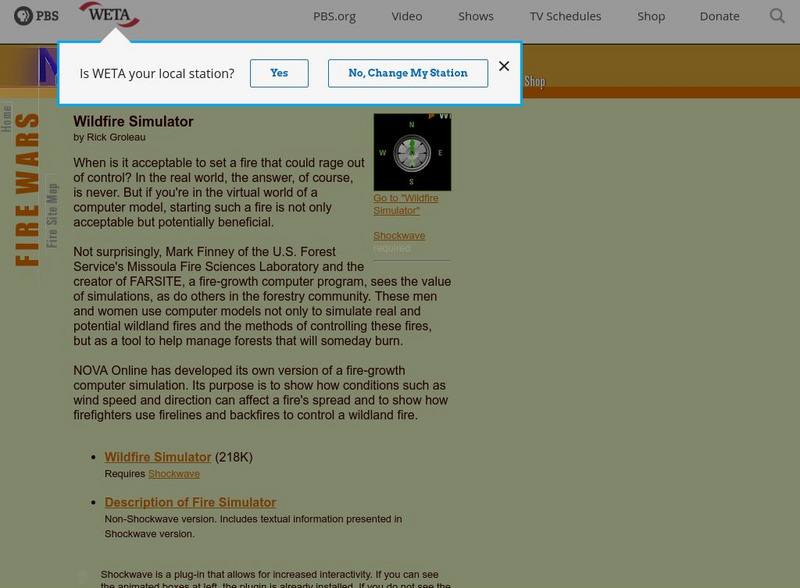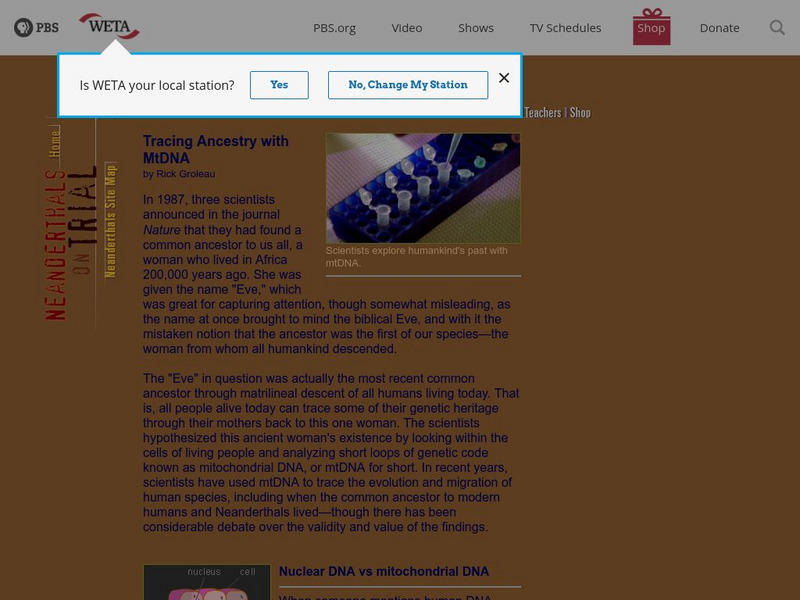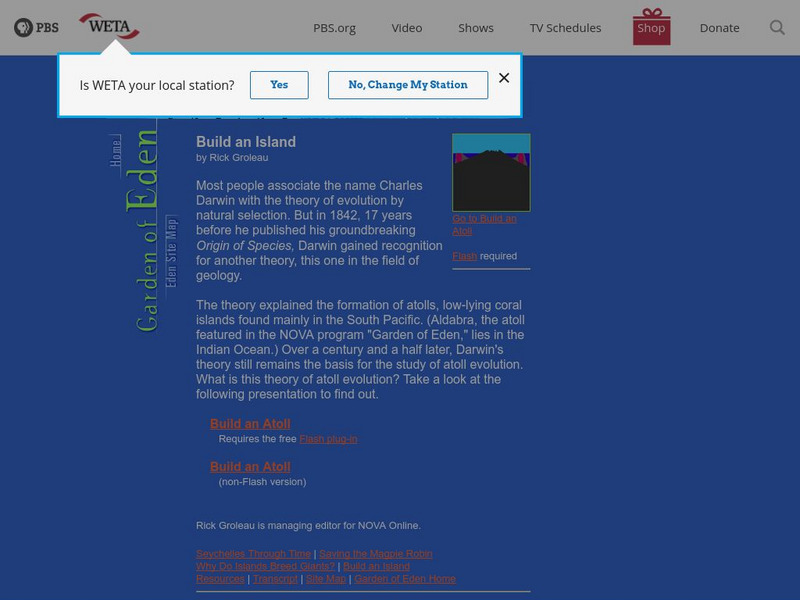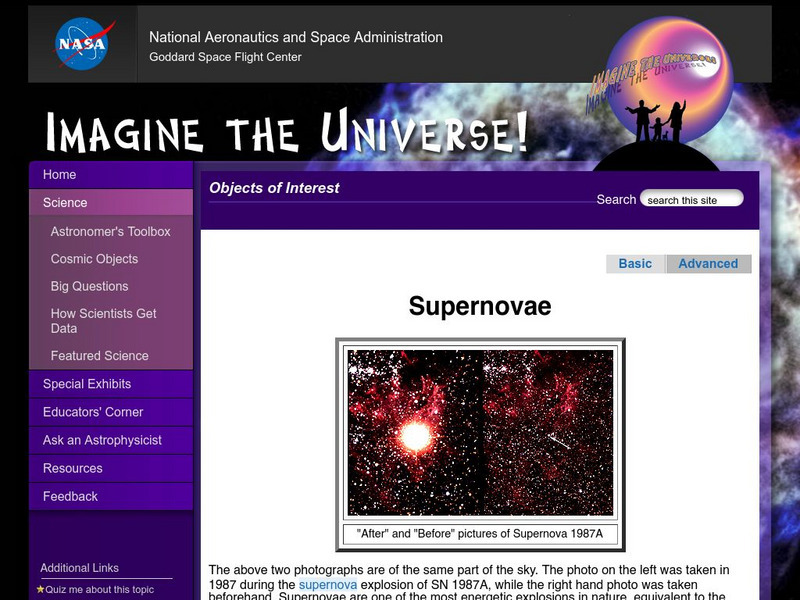PBS
Wildfire Simulator
Do you have what it takes to stop a forest fire? In this simulation you'll have to decide where to put a fire break and a backfire in order to save a house that's about to be engulfed in flames.
PBS
Pbs Nova: Glacier Hazards From Space
View a satelite-generated slideshow that shows some of the hazards that glaciers pose as they break away or melt.
PBS
Nova: Seeing Through Camouflage
See if you can identify the type of camouflage shown in 12 different animals. Types of camouflage include mimicry, disguise, disruptive coloration,and concealing coloration.
PBS
Tracing Ancestry With Mt Dna
The most common mtDNA ancestor is an African woman named African "Eve" or Mitochondrial Eve. Good explanation of mtDNA versus nuclear DNA through visual interactive family tree.
PBS
Nova: Seismic Signals
Scientists have determined that the earthquakes preceding volcanic eruptions are different than those that precede earthquakes. Discover the sounds and wave patterns produced by the three different types of volcanic seismic activities.
PBS
Nova: Explore Madagascar
This resource is a nice overview of Madagascar. Explore the organisms, habitats and geography of Madagascar. Plenty of pictures as well as 360 degree panoramic views make it worth investigating.
PBS
Nova: Build an Island
Trace the development of a type of coral reef known as an atoll. A series of animations show you how an atoll can develop from a volcanic island.
PBS
Pbs: Nova: Making Vaccines
Here's some virtual hands on experience for students. There are many types of vaccines and students may have a hard time understanding the processes. This interactive site requires the student to go through each procedure to make a type...
PBS
Nova Online: Island of the Sharks
A beautiful site that incorporates a story with your interactive exploration of shark anatomy. Use this site for it's great images and fun learning activity.
PBS
Nova: Volcano Under the City
Nyiragongo, a stratovolcano located north of the city of Goma in the Democratic Republic of Congo threatens an entire city. Learn about this active volcano here and how it impacts those who live in this precarious location.
PBS
Pbs: Nova: Hitler's Lost Sub
The companion website to the documentary about German U-boats and the loss of the U-869 in particular. A video clip [1:31], interactive tours of the submarine, and other primary sources are included.
PBS
Pbs Nova: Crocodiles!
This PBS Nova site lists a table of contents on subjects involving the Crocodile. How did they outlive the dinosaurs? What makes them tick? What are the different types of crocodiles?
PBS
Nova: Secrets, Lies, and Atomic Spies
The companion site to the show by the same title. Interesting site allows the reader to decipher a coded message. Information on Venona Intercepts and interviews with children of famous spies.
PBS
Nova Online: Secrets of Making Money
Read about the history of money, how a $100 bill is designed, and find out about the efforts of the Department of the Treasury and Secret Service strive to stay one step ahead of counterfeiters. Check out a counterfeit bill to see what...
PBS
Pbs Nova: Rna Virtual Lab
Play the role of a molecular engineer by solving RNA folding puzzles. Then take these new skills to Eterna, and design RNAs that could be at the heart of future life-saving therapies.
PBS
Nova: On Fire
This resource provides an overview of the basics of combustion. Explore how a fire ignites, how molecules rearrange themselves and what a flame is made of.
PBS
Pbs: Nova: Illuminating Photosynthesis
To understand the process of photosynthesis, follow the hydrogen, carbon, and oxygen atoms as they travel between the air, the plant, and the soil.
PBS
Pbs: Dogs and More Dogs
NOVA takes a comprehensive look at the origin of different species of dogs in this feature. Interesting information like, why do they come in so many shapes and sizes, and why do they have us right where they want us is provided.
PBS
Nova: Dig and Deduce
This simulation will give you the chance to be an archaeologist and do some field research on Neanderthal artifacts. Dig up the bones and then interpret the evidence.
NASA
Astronomy Picture of the Day: Supernova 1987 A
Details of the brightest supernova of modern times - supernova 1987A in the Large Magellanic Cloud. There are many links for additional information.
PBS
Pbs: Nova: The Secret Life of Scientists and Engineers
This series of videos about inspirational scientists and engineers looks at their passions both inside and outside the laboratory.
NASA
Nasa: Imagine the Universe: Supernovae (Basic)
A detailed description of a supernova developing from a single massive star. There is a quiz, related links, animation, lesson plans, and an FAQ sheet available also.
NASA
Nasa: Imagine the Universe: Supernovae Remnants
A brief description of supernova remnants with many embedded links to help define terms used in the description. The specific topics are age and the importance of remnants to us and the types. Definitions of key words are provided.
NASA
Nasa: Imagine the Universe: Supernovae (Advanced)
Supernovae are divided into two basic physical types, including a description of supernova types and how they are classified based on the existence of hydrogen spectral lines. Definitions of key terms are provided.

























